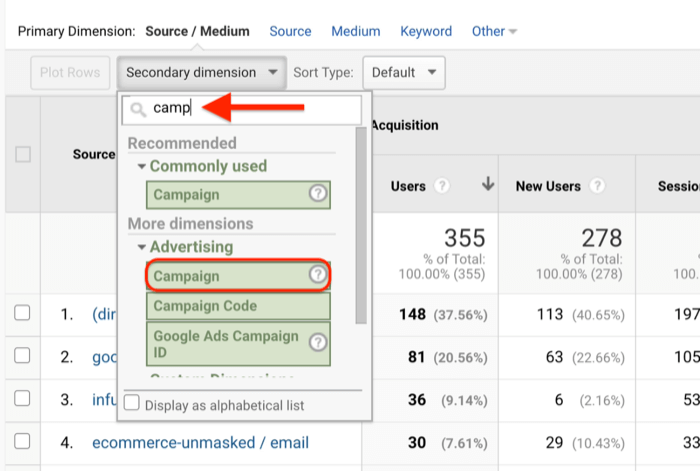Explained: The Function and Meaning of a 'Secondary Dimension' in Google Analytics
Explained: The Function and Meaning of a 'Secondary Dimension' in Google Analytics
Blog Article
Deciphering the Relevance of Secondary Dimension in Google Analytics: All Concerning Its Relevance and Influence
In the world of electronic analytics, the usage of additional dimensions within Google Analytics works as a critical tool for critical deeper layers of information insights. The importance of additional measurements exists in their capability to offer a nuanced sight of customer habits and communication with a web site or system. By studying information past surface-level metrics, companies can open a riches of info that shapes tactical choices and refines advertising efforts. This exploration right into the world of secondary dimensions not just uses a comprehensive understanding of customer engagement however also clarifies the intricate characteristics that drive online performance.
Understanding Second Measurements in Google Analytics
The understanding of secondary measurements in Google Analytics is vital for acquiring much deeper insights right into customer habits and site performance. While primary measurements provide basic information factors such as traffic sources and web page views, additional measurements allow for an extra nuanced evaluation by supplying extra context to these primary metrics. By incorporating additional dimensions, customers can sector and filter their information to reveal patterns and trends that might not be right away apparent.

Introducing the Conveniences of Secondary Measurements
Structure upon the fundamental understanding of secondary measurements in Google Analytics, discovering the benefits they use reveals vital insights for boosting data analysis and decision-making. By including secondary measurements, customers can delve much deeper right into their information, getting a much more detailed view of user actions, material efficiency, and other crucial metrics. One of the main benefits is the capability to sector data, enabling for a more granular analysis of numerous measurements such as website traffic resources, devices, demographics, and much more. When looking at information in aggregate., this division enables individuals to identify patterns, fads, and relationships that might not be obvious (what is a “secondary dimension” in google analytics?).
Moreover, additional measurements provide context to main information, using added layers of details that can help in understanding individual communications and preferences. This improved understanding can assist critical decision-making, bring about even more targeted marketing projects, site optimizations, and overall better efficiency. Fundamentally, additional dimensions offer as a powerful tool for unlocking deeper insights and making the most of the energy of Google Analytics for organizations and website owners.
Leveraging Additional Dimensions for Enhanced Insights
By using the power of second dimensions in Google Analytics, companies can reveal much deeper understandings that drive notified decision-making and calculated blog optimization efforts. Leveraging additional dimensions enables companies to dig beyond surface-level data and get an extra detailed understanding of individual actions, audience demographics, website traffic sources, and internet site efficiency. By incorporating main dimensions like web traffic sources with second measurements such as geographic area or device classification, companies can identify which regions or devices are driving the most useful web traffic to their website.
Moreover, secondary measurements make it possible for services to segment and analyze data better, assisting them recognize patterns, patterns, and opportunities that may have otherwise gone unnoticed. By making use of additional measurements, companies can tailor their advertising and marketing approaches, web content, and user experience to much better meet the requirements and choices of their target audience. Fundamentally, leveraging second dimensions in Google Analytics equips businesses to make data-driven choices that lead to enhanced performance, raised ROI, and lasting growth.

Impact of Additional Measurements on Information Evaluation
Enhancing information evaluation through the usage of additional dimensions in Google Analytics offers companies with a deeper understanding of their on-line performance metrics. By including additional measurements, such as time of day, geographic area, or device group, services can discover important understandings that might have been forgotten with main dimensions alone. This improved degree of granularity allows for even more accurate segmentation of information, making it possible for companies to determine patterns, fads, and relationships that can drive strategic decision-making.

Optimizing Possible: Second Dimensions Strategies
The calculated use of secondary dimensions in Google Analytics expands beyond boosting information evaluation; it involves crafting targeted approaches to unlock the full potential of important understandings for service development. By using additional measurements efficiently, organizations can dig much deeper into their website web traffic, user actions, and advertising projects to extract workable insights. One vital method is to combine additional measurements with primary measurements to obtain a detailed sight of user communications. For example, coupling the primary dimension of 'source/medium' with secondary measurements like 'touchdown web page' or 'device group' can disclose visit the site which channels are driving web traffic to specific web pages or just how customer habits differs across gadgets.
Additionally, using second measurements to sector information based on individual demographics, actions, or modern technology can aid businesses customize their marketing initiatives to details target market sectors. This targeted technique can result in improved conversion prices, improved customer experiences, and ultimately, boosted ROI. By maximizing the potential of second dimensions in Google Analytics, companies can make educated decisions, enhance their online presence, and drive sustainable development.
Final Thought
In verdict, secondary dimensions in Google Analytics play a critical duty in supplying much visit this web-site deeper understandings and boosting information analysis. Integrating second measurements into information analysis methods can lead to more educated decision-making and improved total performance.
While key dimensions offer fundamental data points such as web traffic sources and page sights, additional dimensions allow for a more nuanced analysis by supplying extra context to these key metrics. By integrating key measurements like website traffic sources with additional dimensions such as geographical location or device category, businesses can determine which devices or areas are driving the most valuable traffic to their website.
By incorporating secondary measurements, such as time of day, geographic location, or tool classification, companies can discover beneficial understandings that may have been forgotten with key measurements alone. One key technique is to incorporate secondary dimensions with key dimensions to obtain an extensive sight of customer interactions. Coupling the key dimension of 'source/medium' with additional dimensions like 'landing page' or 'tool group' can expose which networks are driving website traffic to particular web pages or exactly how customer behavior differs throughout tools.
Report this page